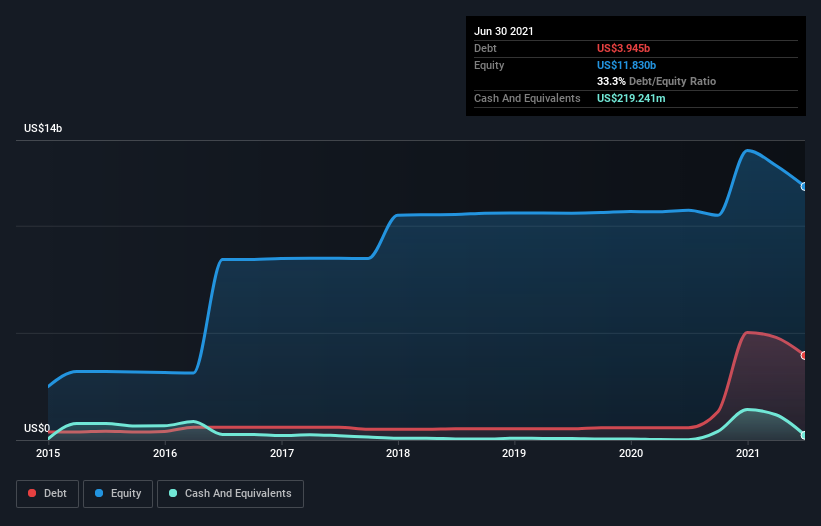Stock Analysis
- United States
- /
- Media
- /
- NasdaqGS:LBRD.K
Does Liberty Broadband (NASDAQ:LBRD.K) Have A Healthy Balance Sheet?

Some say volatility, rather than debt, is the best way to think about risk as an investor, but Warren Buffett famously said that 'Volatility is far from synonymous with risk.' It's only natural to consider a company's balance sheet when you examine how risky it is, since debt is often involved when a business collapses. As with many other companies Liberty Broadband Corporation (NASDAQ:LBRD.K) makes use of debt. But the real question is whether this debt is making the company risky.
When Is Debt Dangerous?
Generally speaking, debt only becomes a real problem when a company can't easily pay it off, either by raising capital or with its own cash flow. Ultimately, if the company can't fulfill its legal obligations to repay debt, shareholders could walk away with nothing. While that is not too common, we often do see indebted companies permanently diluting shareholders because lenders force them to raise capital at a distressed price. Of course, debt can be an important tool in businesses, particularly capital heavy businesses. The first thing to do when considering how much debt a business uses is to look at its cash and debt together.
Check out our latest analysis for Liberty Broadband
What Is Liberty Broadband's Net Debt?
The image below, which you can click on for greater detail, shows that at June 2021 Liberty Broadband had debt of US$3.94b, up from US$573.6m in one year. However, it also had US$219.2m in cash, and so its net debt is US$3.73b.

How Strong Is Liberty Broadband's Balance Sheet?
The latest balance sheet data shows that Liberty Broadband had liabilities of US$728.9m due within a year, and liabilities of US$6.22b falling due after that. Offsetting this, it had US$219.2m in cash and US$233.6m in receivables that were due within 12 months. So its liabilities outweigh the sum of its cash and (near-term) receivables by US$6.49b.
Liberty Broadband has a very large market capitalization of US$29.8b, so it could very likely raise cash to ameliorate its balance sheet, if the need arose. But we definitely want to keep our eyes open to indications that its debt is bringing too much risk. There's no doubt that we learn most about debt from the balance sheet. But it is future earnings, more than anything, that will determine Liberty Broadband's ability to maintain a healthy balance sheet going forward. So if you're focused on the future you can check out this free report showing analyst profit forecasts.
In the last year Liberty Broadband wasn't profitable at an EBIT level, but managed to grow its revenue by 3,247%, to US$531m. That's virtually the hole-in-one of revenue growth!
Caveat Emptor
Despite the top line growth, Liberty Broadband still had an earnings before interest and tax (EBIT) loss over the last year. Indeed, it lost US$36m at the EBIT level. Considering that alongside the liabilities mentioned above does not give us much confidence that company should be using so much debt. So we think its balance sheet is a little strained, though not beyond repair. Another cause for caution is that is bled US$20m in negative free cash flow over the last twelve months. So to be blunt we think it is risky. The balance sheet is clearly the area to focus on when you are analysing debt. But ultimately, every company can contain risks that exist outside of the balance sheet. To that end, you should be aware of the 3 warning signs we've spotted with Liberty Broadband .
Of course, if you're the type of investor who prefers buying stocks without the burden of debt, then don't hesitate to discover our exclusive list of net cash growth stocks, today.
Valuation is complex, but we're helping make it simple.
Find out whether Liberty Broadband is potentially over or undervalued by checking out our comprehensive analysis, which includes fair value estimates, risks and warnings, dividends, insider transactions and financial health.
View the Free AnalysisThis article by Simply Wall St is general in nature. We provide commentary based on historical data and analyst forecasts only using an unbiased methodology and our articles are not intended to be financial advice. It does not constitute a recommendation to buy or sell any stock, and does not take account of your objectives, or your financial situation. We aim to bring you long-term focused analysis driven by fundamental data. Note that our analysis may not factor in the latest price-sensitive company announcements or qualitative material. Simply Wall St has no position in any stocks mentioned.
Have feedback on this article? Concerned about the content? Get in touch with us directly. Alternatively, email editorial-team (at) simplywallst.com.
About NasdaqGS:LBRD.K
Slightly overvalued with questionable track record.

